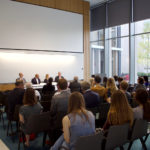
Living with the impact of reconstruction on Allston, residents gathered at a public meeting Tuesday at the Jackson/Mann K-8 School to gain input from the community and officials.
The meeting, hosted by the Massachusetts Department of Transportation’s I-90 Allston Interchange Improvement Project, saw experts and attendees speak about construction on the Massachusetts Turnpike and other redevelopment within the city.
The proposal for the transportation reform project began in April, 2014, and has progressed to its current planning and development stage, according to the MassDOT website.
A full contract is expected to be awarded in 2017 with construction beginning in the second half of 2018 and completion of the project carrying into early 2023.
Michael O’Donnell, project manager of the project, announced the firm’s findings at the meeting. There are three proposals for the reconstruction project that are currently being considered, he said.
“I am pleased to report that their findings were presented to the senior leadership teams at [MassDOT] and the direction is that both of those concepts are going to be advanced into a Massachusetts Environmental Policy Act process,” he said.
All three concepts presented at the meeting share the same priorities for improving safety for all modes of transportation, O’Donnell said. Some of these priorities include paying special attention to walking, cycling, driving and transit throughout the Allston neighborhood.
Additional plans include the realignment of Interstate 90, improvements to Cambridge Street to better accommodate all modes of transportation, increased accessibility to transit at the planned West Station and the protection of the Allston neighborhood during construction.
David Grissino, an urban designer for the Boston Redevelopment Authority, explained the importance of choosing plans that are environmentally sound.
“You have to be able to demonstrate that you are selecting the least environmentally damaging prudent alternative,” Grissino said. “[This] is very preliminary judgment that we are making here, we just felt like it was something that was worth pointing out.”
While several plans are underway, Grissino said the BRA’s estimation of cost have not yet been determined because the projects are still in the early stages of planning.
Several attendees said that they hope to see more public discussions about the changes that are taking place in Allston and surrounding neighborhoods.
Pedro Villanueva, 27, of Allston, said he grew up in the neighborhood and is interested in the effect transportation has on the area.
“As far as Allston I feel like it’s very important for me to see what happens to Allston as well as the city as a bigger project this is not only affecting Allston but it should affect Boston and Cambridge and all that,” he said.
Bram Peterson, 21, a senior in Boston University’s College of Arts and Sciences, said he is also concerned about improvements for the bicycling routes.
“We are already going to see some improvements on Boston University’s campus next year in terms of construction that will be completed in the next two years, however, the surrounding BU areas are still lacking in terms of bike and pedestrian infrastructure,” he said. “This is a chance for BU to really be linked in terms of bike and pedestrian infrastructure in a better way to the surrounding areas.”
Matt Cadwallader, 29, of Allston, said he is interested to see how the project will impact the city in the future.
“I’m just very curious to see what they’re going to do with it. There’s more land over in North Allston than I think the entirety of the Back Bay,” he said. “Development right now in the city is going crazy. What we’re going to do with all this open land right now is really going to make a difference in the future.”
Cadwallader, who regularly rides his bike to his job at Harvard University, said he hopes to see safer streets prioritized as a part of the reconstruction plans.
“All of those things are important to me and right now the way things are organized with Cambridge Street, which is this wide boulevard that’s dangerous and difficult to cross,” he said, “It’s not the kind of road that you often see in Boston. [And] so I’m hoping that they’re trying to limit that while adding transportation options like West Station.”














